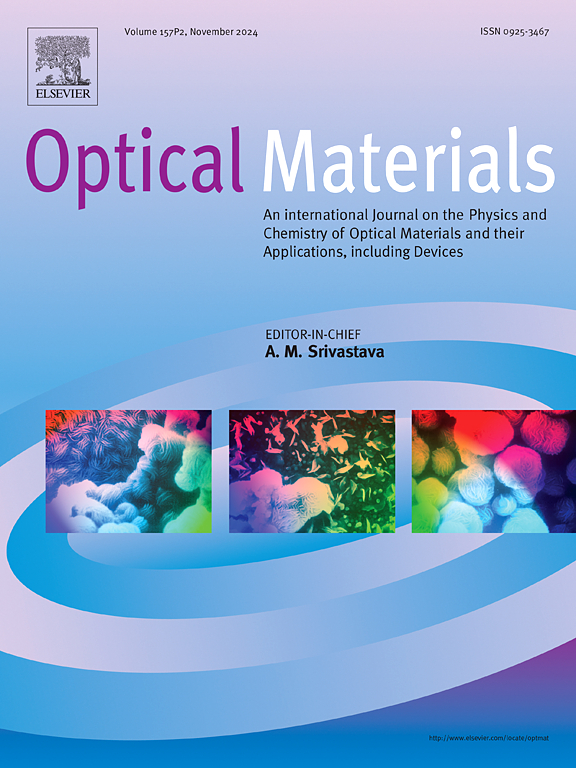Integrated photon sensor based on Ti3C2Tx MXene film and microgroove Mach-Zehnder Interferometer
IF 3.8
3区 材料科学
Q2 MATERIALS SCIENCE, MULTIDISCIPLINARY
引用次数: 0
Abstract
Optical waveguide refractive index (RI) sensors have significant potential in various environmental-monitoring fields. Given the limitations of waveguide materials, enhancing the sensitivity of the optical waveguide sensors requires materials functionalization. Moreover, the sensor structure requires a specialized design to enhance its sensitivity. In this study, a hybrid optical waveguide RI sensor was used fabricated by integrating a Ti3C2Tx MXene film with a Microgroove Mach–Zehnder Interferometer (MMZI). First, the sensor arm is etched to create a microgroove structure, which enhances the interaction between the sensor arm and the external environment. Second, the agglomeration of MXene was inhibited by vacuum filtration, resulting in a large-area, self-supporting MXene membranes. Finally, an MXene self-supporting film was prepared and precisely transferred to the microgroove of the sensing arm to create a wafer-level MXene-Based Composite Waveguide Sensors. The experimental results demonstrate a linear relationship between the light intensity drift of the sensing probe and the RI change with the sensor sensitivity measured at −738 dB/RIU and a linear correlation coefficient of 0.99758. Additionally, this study employed the density functional theory (DFT) to calculate the RI parameters of the MXene materials. This type of Composite Waveguide Sensors can be mass-produced using semiconductor processing technology and has broad applications in fields such as environmental monitoring.
基于Ti3C2Tx MXene薄膜和微槽马赫曾德尔干涉仪的集成光子传感器
光波导折射率传感器在各种环境监测领域具有重要的应用前景。由于波导材料的局限性,提高光波导传感器的灵敏度需要材料功能化。此外,传感器结构需要专门设计以提高其灵敏度。在本研究中,采用Ti3C2Tx MXene薄膜与微槽马赫-曾德干涉仪(MMZI)集成的方法制备了一种混合光波导RI传感器。首先,对传感器臂进行蚀刻,形成微槽结构,增强了传感器臂与外部环境的相互作用。其次,真空过滤抑制了MXene的团聚,形成大面积、自支撑的MXene膜。最后,制备了MXene自支撑薄膜,并将其精确转移到传感臂的微沟槽中,形成了基于MXene的晶圆级复合波导传感器。实验结果表明,传感器灵敏度为- 738 dB/RIU时,探头光强漂移与RI变化呈线性关系,线性相关系数为0.99758。此外,本研究采用密度泛函理论(DFT)计算了MXene材料的RI参数。这种类型的复合波导传感器可以采用半导体加工技术批量生产,在环境监测等领域有着广泛的应用。
本文章由计算机程序翻译,如有差异,请以英文原文为准。
求助全文
约1分钟内获得全文
求助全文
来源期刊

Optical Materials
工程技术-材料科学:综合
CiteScore
6.60
自引率
12.80%
发文量
1265
审稿时长
38 days
期刊介绍:
Optical Materials has an open access mirror journal Optical Materials: X, sharing the same aims and scope, editorial team, submission system and rigorous peer review.
The purpose of Optical Materials is to provide a means of communication and technology transfer between researchers who are interested in materials for potential device applications. The journal publishes original papers and review articles on the design, synthesis, characterisation and applications of optical materials.
OPTICAL MATERIALS focuses on:
• Optical Properties of Material Systems;
• The Materials Aspects of Optical Phenomena;
• The Materials Aspects of Devices and Applications.
Authors can submit separate research elements describing their data to Data in Brief and methods to Methods X.
 求助内容:
求助内容: 应助结果提醒方式:
应助结果提醒方式:


